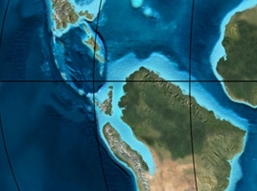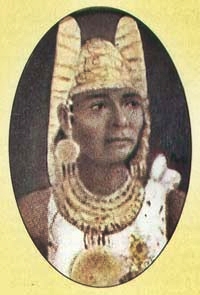|
Nemocón
Nemocón is a municipality and town of Colombia in the Central Savanna Province, part of the department of Cundinamarca. Nemocón, famous for its salt mine, was an important village in the Muisca Confederation, the country in the central Colombian Andes before the arrival of the Spanish. The municipality is situated in the northern part of the Bogotá savanna, part of the Altiplano Cundiboyacense with its urban centre at an altitude of and from the capital Bogotá. Nemocón is the northeasternmost municipality of the Metropolitan Area of Bogotá and the Bogotá River originates close to Nemocón. The median temperature of Nemocón is 12.8 °C. The municipality borders Tausa in the north, Zipaquirá and Gachancipá in the south, Suesca in the east, and Cogua in the west. Muisca economy#Ceramics, Ceramics of this period found in Nemocón originated from farther away on the Altiplano and ceramics of Nemocón and Zipaquirá found elsewhere on the Bogotá savanna are related ... [...More Info...] [...Related Items...] OR: [Wikipedia] [Google] [Baidu] |
Bogotá Savanna
The Bogotá savanna is a savanna#Savanna ecoregions, montane savanna, located in the southwestern part of the Altiplano Cundiboyacense in the center of Colombia. The Bogotá savanna has an extent of and an average altitude of . The savanna is situated in the Cordillera Oriental (Colombia), Eastern Ranges of the Colombian Andes. The Bogotá savanna is crossed from northeast to southwest by the long Bogotá River, which at the southwestern edge of the plateau forms the Tequendama Falls (''Salto del Tequendama''). Other rivers, such as the Subachoque River, Subachoque, Bojacá River, Bojacá, Fucha River, Fucha, Soacha River, Soacha and Tunjuelo Rivers, tributaries of the Bogotá River, form smaller valleys with very fertile soils dedicated to agriculture and cattle-breeding. Before the Spanish conquest of the Muisca, Spanish conquest of the Bogotá savanna, the area was inhabited by the indigenous Muisca people, Muisca, who formed a loose confederation of various ''caciques'', na ... [...More Info...] [...Related Items...] OR: [Wikipedia] [Google] [Baidu] |
Muisca Confederation
The Muisca Confederation was a loose confederation of different Muisca rulers (''zaques'', ''zipas'', ''iraca'', and ''tundama'') in the central Andes, Andean highlands of what is today Colombia before the Spanish conquest of the Americas, Spanish conquest of northern South America. The area, presently called Altiplano Cundiboyacense, comprised the current departments of Colombia, departments of Boyacá Department, Boyacá, Cundinamarca Department, Cundinamarca and minor parts of Santander Department, Santander. According to some List of Muisca scholars, Muisca scholars the Muisca Confederation was one of the best-organized confederations of tribes on the South American continent. Other Historian, historians and anthropologists, however, such as Jorge Gamboa Mendoza, attribute the present-day knowledge about the confederation and its organization more to a reflection by Spanish chroniclers who predominantly wrote about it a century or more after the Muisca were conquered and propo ... [...More Info...] [...Related Items...] OR: [Wikipedia] [Google] [Baidu] |
Zipaquirá
Zipaquirá () is a municipality and city of Colombia in the department of Cundinamarca. Its neighboring municipalities are Cogua and Nemocón to the north; Tabio, Cajicá and Sopó to the south, Tocancipá and Gachancipá to the east and Pacho and Subachoque to the west. Its seat of municipal government is 49 kilometers from the national capital Bogotá. It is part of the Greater Bogotá Metropolitan Area, and is the capital of the Sabana Centro province. It is also the headquarters of the diocese of the same name and that includes much of the Department of Cundinamarca, extending to the centre of Bogotá, the region of Rionegro, the Ubaté Valley, and the region of Guavio. The city is primarily known for its Salt Cathedral, an underground church built inside a salt mine in a tunnel made as result of the excavation of the ''salinas''. Zipaquirá has an original architecture, and the old city centre is a tourist attraction. Its main square is surrounded by old buildings ... [...More Info...] [...Related Items...] OR: [Wikipedia] [Google] [Baidu] |
Ana María Groot
Ana María Groot de Mahecha (born 29 August 1952 in Bogotá) is a Colombian historian, archaeologist, anthropologist and associate professor at the Department of Anthropology of the National University of Colombia, Universidad Nacional de Colombia. Ana Mariá Groot speaks Spanish, English and French.Curriculum Vitae Ana María Groot Biography Ana María Groot de Mahecha (other sources give second last name Sáenz) was born in Bogotá on 29 August 1952. She attended the ''Colegio Santa Francisca Romana'' and studied anthropology at the University of Los Andes (Colombia), Universidad de los Andes, obtaining her MSc. title in 1974 with a thesis named ''Excavaciones Arqueológicas en Tierradentro. Estudio sobre cerámica y su posible uso ...[...More Info...] [...Related Items...] OR: [Wikipedia] [Google] [Baidu] |
Central Savanna Province
Central Savanna Province () is one of the fifteen provinces of Cundinamarca Department, Cundinamarca, in Colombia. It is located in the central area of the department, and has 11 Municipalities of Colombia, municipalities. The province capital is the city of Zipaquirá. Limits * North: Ubaté Province * West: Rionegro Province, Rionegro and Western Savanna Province * South: Bogotá, Bogotá Capital District * East: Guavio Province * Northeast: Almeidas Province Rivers The Central Savanna Province is crossed by the Bogotá River and Rio Frío (Colombia), Rio Frío. Demographics The most populous urban centers are Chía, Cundinamarca, Chía and Zipaquirá. Subdivision The Central Savanna Province is subdivided into 11 municipalities:Orden en las provincias de Cundinamarca - ... [...More Info...] [...Related Items...] OR: [Wikipedia] [Google] [Baidu] |
Tausa
Tausa () is a municipality and town of Colombia in the Ubaté Province, part of the department of Cundinamarca. Tausa is and was an important town on the Altiplano Cundiboyacense due to its salt mine. It was the third most prolific salt deposit for the original inhabitants of the area; the Muisca. Tausa's urban centre is located at an elevation of (other parts of the municipality reach elevations of ) and a distance of from the capital Bogotá. The municipality borders San Cayetano, Carmen de Carupa and Sutatausa in the north, Pacho in the west, Sutatausa, Cucunubá and Suesca in the east and in the south with Nemocón and Cogua. Etymology The name Tausa comes from Chibcha and means "tribute".Espejo Olaya, 1999, p.1124 History Tausa was inhabited since the Herrera Period. The town was an important mining location of halite for the Muisca. The ''zipa'' of Bacatá ruled over Tausa. The mining activities can be seen in the seal of the village; the pick and spade. Modern ... [...More Info...] [...Related Items...] OR: [Wikipedia] [Google] [Baidu] |
Cogua
Cogua () is a municipality and town of Colombia in the department of Cundinamarca. It is situated on northern part of the Bogotá savanna with the urban centre at an altitude of at from the capital Bogotá. Cogua borders Tausa in the north, Nemocón in the east, Pacho in the west and Zipaquirá in the south.Official website Cogua Etymology The name Cogua is derived from and means "Support of the hill".History Cogua in the times before the |
Altiplano Cundiboyacense
The Altiplano Cundiboyacense () is a high plateau located in the Eastern Cordillera of the Colombian Andes covering parts of the departments of Cundinamarca and Boyacá. (Do not confuse with The Altiplano or the Altiplano Nariñense, both further south.) The altiplano corresponds to the ancient territory of the Muisca. The Altiplano Cundiboyacense comprises three distinctive flat regions; the Bogotá savanna, the valleys of Ubaté and Chiquinquirá, and the valleys of Duitama and Sogamoso. The average altitude of the altiplano is about above sea level but ranges from roughly to . Etymology ''Altiplano'' in Spanish means "high plain" or "high plateau", the second part is a combination of the departments Cundinamarca and Boyacá. Geography The limits of the Altiplano are not strictly defined. The high plateau is enclosed by the higher mountains of the Eastern Ranges, with the Sumapaz mountains in the south and Chingaza to the east. The Tenza Valley is locate ... [...More Info...] [...Related Items...] OR: [Wikipedia] [Google] [Baidu] |
Nemequene
Nemequene or Nemeguene (died 1514) was the third ruler (''zipa'') of Bacatá as of 1490. His '' zaque'' counterpart ruling over the northern area of the Muisca territory was Quemuenchatocha. Etymology Nemequene in the Chibcha language of the Muisca has two possible meanings, derived from the words ''nymy'', " jaguar" and ''quyne'', meaning either "bone" or "force". Biography Nemequene succeeded to the throne of the southern Muisca in 1490 after the death of his predecessor Saguamanchica in the Battle of Chocontá where the ''zaque'' of the northern Muisca Michuá had also died. While Nemequene wanted to continue the attacks against the northern Muisca, he had to face the dangers of the Panche to the west of his territory. Nemequene installed his nephew and legal successor Tisquesusa as army general to fight off the Panche with success. Looking to expand the territory of the southern Muisca, Nemequene succeeded in the conquest of other areas in the central highlands o ... [...More Info...] [...Related Items...] OR: [Wikipedia] [Google] [Baidu] |
Suesca
Suesca is a town and municipality in the Almeidas Province, part of the department of Cundinamarca Department, Cundinamarca, Colombia. It is located on the Altiplano Cundiboyacense, north of the capital Bogotá. Suesca forms the northern edge of the Bogotá savanna and is a scenic countryside town which is well known because its landscape attracts devotees of rock climbing, trekking, and rafting. It is surrounded by dairy farms and flower plantations. The municipality borders Cucunubá and Lenguazaque in the north, Sesquilé and Gachancipá in the south, Chocontá in the east and Nemocón in the west. Etymology The name Suesca is derived from the Chibcha language, Chibcha word ''Suejica'', ''Sueica''Wills et al., 2001, Ch.43 - Rocas de Suesca - paraíso de escaladores, p.163 or ''Suesuca'', which means "Rock of the birds" or "Tail of the macaw". [...More Info...] [...Related Items...] OR: [Wikipedia] [Google] [Baidu] |
Gachancipá
Gachancipá is a municipality and town of Colombia in the Central Savanna Province, part of the department of Cundinamarca. The urban centre is located on the Altiplano Cundiboyacense at from the capital Bogotá. The municipality borders Suesca and Nemocón in the north, Tocancipá in the south, Sesquilé and Guatavita in the east and Zipaquirá in the west.Official website Gachancipá Etymology The name Gachancipá comes from and means "Pottery of the ''zipa''".History The area of Gachancipá before the |
Bogotá
Bogotá (, also , , ), officially Bogotá, Distrito Capital, abbreviated Bogotá, D.C., and formerly known as Santa Fe de Bogotá (; ) during the Spanish Imperial period and between 1991 and 2000, is the capital city, capital and largest city of Colombia, and one of the List of largest cities, largest cities in the world. The city is administered as the Capital District, as well as the capital of, though not politically part of, the surrounding department of Cundinamarca Department, Cundinamarca. Bogotá is a territorial entity of the first order, with the same administrative status as the departments of Colombia. It is the main political, economic, administrative, industrial, cultural, aeronautical, technological, scientific, medical and educational center of the country and northern South America. Bogotá was founded as the capital of the New Kingdom of Granada on 6 August 1538 by Spanish conquistador Gonzalo Jiménez de Quesada after a harsh Spanish conquest of the Muisca, e ... [...More Info...] [...Related Items...] OR: [Wikipedia] [Google] [Baidu] |





